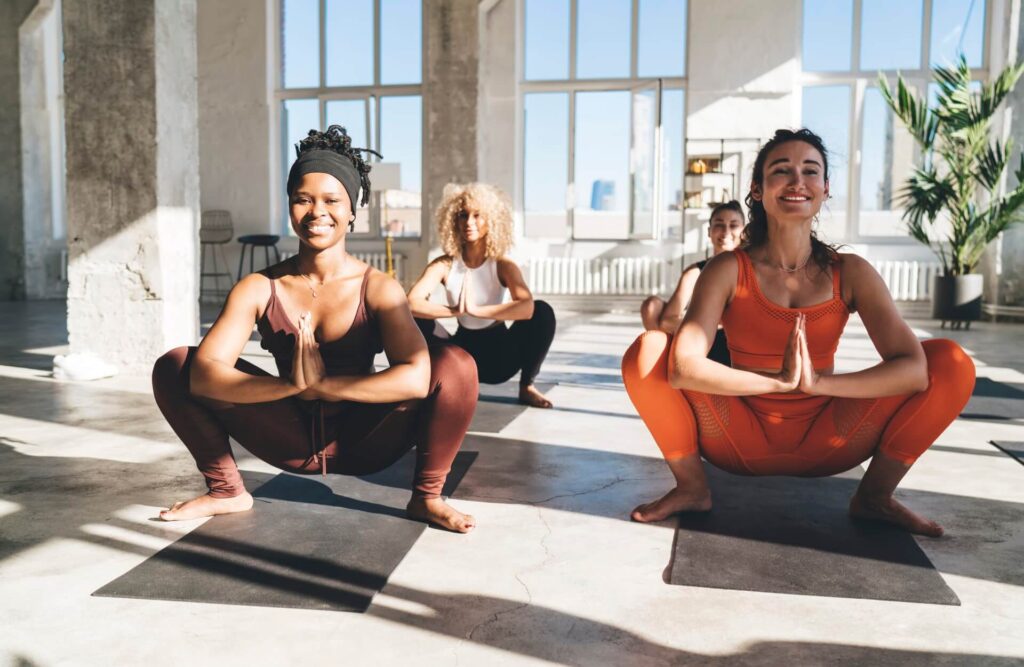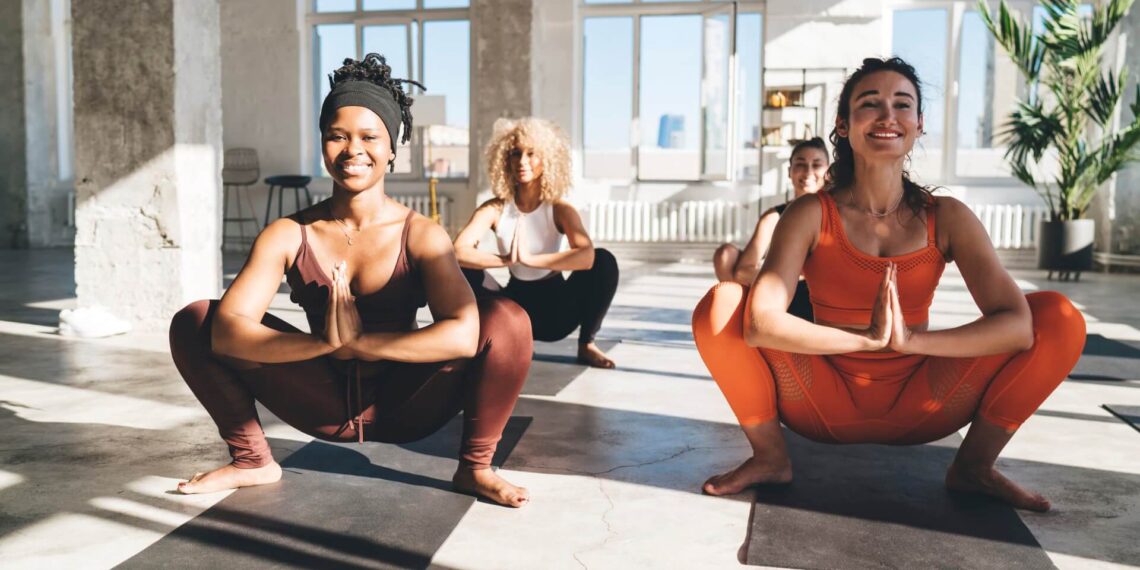“In the Squat Pose, we return to a primal posture, reconnecting with the simplicity of existence and finding strength in our roots.” Squat Pose Malasana
Squat Pose, also known as Malasana in Sanskrit, is an intermediate-level yoga posture that blends strength, flexibility, and grounding. In this asana, practitioners assume a deep squatting position, with the feet close together and the arms gently pressed against the inner thighs. Malasana offers a unique challenge for those seeking to advance their yoga practice beyond the basics.
Malasana is celebrated for its ability to open the hips, strengthen the lower body, and foster a sense of stability and rootedness. It’s a pose that encourages both physical and mental balance. Whether you’re progressing from a beginner level or looking to refine your practice, this comprehensive guide will introduce you to the essential techniques and alignment cues for Squat Pose, allowing you to experience its physical and mental benefits as an intermediate practitioner.
Squat Pose, or Malasana in Sanskrit, is a powerful yoga posture that combines strength, flexibility, and balance. While it may seem simple at first glance, mastering Malasana requires intermediate-level yoga skills. This pose engages the lower body, enhances hip mobility, and cultivates both physical and mental balance.
Meaning of Malasana Pose
Malasana, commonly known as Garland Pose or Yoga Squat, is a yoga posture rich in symbolism and cultural significance. The name “Malasana” has its roots in Sanskrit, where “mala” translates to “garland” or “rosary,” and “asana” refers to “pose” or “posture.” In this asana, the practitioner assumes a deep squatting position with the feet flat on the ground and the hands joined together at the heart’s center.
Malasana symbolizes unity, humility, and a sense of coming together. The squatting position resembles a person sitting in prayer or meditation, with the hands at the heart chakra. It signifies the act of grounding oneself and finding stillness amidst the chaos of life. In some cultural contexts, the garland or rosary is used as a symbol of devotion and meditation. Malasana encourages practitioners to connect with their inner selves, express gratitude, and find peace and serenity in a simple and humble posture. It embodies the idea that, in the quiet moments of introspection, one can discover the beauty and depth of their own being.
Benefits of Squat Pose Malasana
Squat Pose (Malasana) offers a variety of benefits, particularly for intermediate practitioners:
- Hip Flexibility: Regular practice enhances hip flexibility, making it easier to transition into advanced yoga poses.
- Leg and Groin Strength: Malasana strengthens the quadriceps, hamstrings, and adductors, improving lower body muscle tone.
- Digestive Health: The compression of the abdomen can aid digestion and alleviate gastrointestinal discomfort.
- Balanced Energy: Malasana helps balance energy in the pelvic region, fostering a sense of stability and grounding.
- Mental Focus: As an intermediate pose, it requires concentration and mindfulness, enhancing mental clarity and focus.
How to do Squat Pose Malasana

- Starting Position: Begin in a standing position at the front of your yoga mat, with your feet slightly wider than hip-width apart.
- Toes Out: Turn your toes slightly outward to create space for your hips.
- Squat Down: Start to lower your body by bending your knees while keeping your heels on the ground. Aim to bring your buttocks as close to the ground as possible.
- Elbows Inside Knees: Position your elbows on the insides of your knees, pressing them gently outward to create space in the hips.
- Hands at Heart Center: Bring your palms together at heart center, maintaining a straight spine.
- Engage Core: Engage your core muscles to support your lower back and maintain balance.
- Lengthen Spine: Lengthen your spine upward, keeping your chest open and shoulders relaxed.
- Hold and Breathe: Hold the pose for 30 seconds to one minute, breathing deeply and steadily.
- Release: To exit the pose, gently lower your buttocks to the ground, straighten your legs, and return to a standing position.
Squat Pose Malasana Variations and Modifications
If your heels don’t touch the ground, place a folded yoga mat or cushion under them for support. If you’re working towards the full expression of Malasana, you can use yoga blocks under your heels or perform the pose with your back against a wall for balance.
Tips for a Deeper Practice Squat Pose Malasana

Elevate your Squat Pose (Malasana) practice with these tips for a more profound experience. Explore elements like yoga music, preparatory poses, alternative variations, healing crystals, and a personal altar to deepen your session, fostering increased mindfulness and tranquility in your practice.
Preparation Poses Squat Pose Malasana
- Standing Forward Bend (Uttanasana): Standing Forward Bend helps stretch the hamstrings, lower back, and calves, making it an excellent preparatory pose for Malasana. Stand with your feet hip-width apart, hinge at your hips, and bend forward from your waist. Keep your knees slightly bent if needed to reach the floor or grab onto your shins. Relax your neck and aim to bring your chest closer to your thighs. This pose improves hamstring flexibility and gets you used to the forward-bending aspect of Malasana.
- Low Squat (Mild Malasana Variation): The low squat is a transitional variation of Malasana that helps you become comfortable with the squatting position and improve hip flexibility. Stand with your feet wider than hip-width apart and turn your toes slightly outward. Slowly lower yourself into a squat by bending your knees, allowing your hips to sink toward the ground. Keep your heels on the floor, and your elbows can gently push your knees outward. This pose replicates the lower body position of Malasana but with less intensity.
- Happy Baby Pose (Ananda Balasana): Happy Baby Pose is a gentle hip opener that can help prepare the hips and groin for Malasana. Lie on your back and draw your knees toward your chest. Grab the outsides of your feet with your hands, flex your feet, and gently pull your knees toward the floor beside your ribcage. Rock gently from side to side to massage the lower back and hips. This pose increases hip flexibility and awareness.
Alternative Poses Squat Pose Malasana
These alternative poses and modifications can help individuals adapt the practice of Squat Pose (Malasana) to their specific needs and level of flexibility. As with any yoga pose, it’s essential to choose the variation that feels most comfortable and effective for your body while ensuring proper alignment and safety.
- Garland Pose Variation with a Block: This variation of Malasana provides additional support for those who may have difficulty balancing or need assistance in maintaining the squat position. Place a yoga block on its lowest height setting in front of you. Begin to squat down as you would in Malasana. Place your hands on the block for support, allowing your hips to sink lower. This modification helps you find stability and gradually work on squatting deeper.
- Bridge Pose (Setu Bandha Sarvangasana): After Malasana, consider practicing Bridge Pose to counterbalance the forward bending nature of the squat and gently open your chest.
- Supported Squat Pose with Wall: Practicing Malasana with the support of a wall is an excellent option for beginners or individuals who want to work on improving their squat form. Stand with your back against a wall and your feet slightly wider than hip-width apart. Begin to lower yourself into a squat, allowing your back to rest against the wall for support. Use the wall to help you maintain balance and work on your squat posture.
Final Thoughts
Squat Pose (Malasana) is an intermediate-level yoga posture that strengthens the lower body, enhances hip flexibility, and fosters a sense of balance and groundedness. It symbolizes the beauty of simplicity in yoga practice.
Incorporate Malasana into your intermediate practice to experience the physical and mental benefits it offers. It serves as a reminder that yoga encourages growth, both in the strength of your body and the clarity of your mind.


